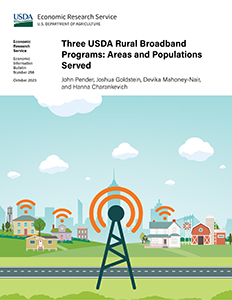Three USDA Rural Broadband Programs: Areas and Populations Served
- by John Pender, Joshua Goldstein, Devika Mahoney-Nair and Hanna Charankevich
- 10/12/2023
Overview
This study investigates the areas and populations served by three USDA rural broadband programs—the Broadband Initiatives Program (BIP), the Community Connect grant program, and the ReConnect program. BIP was the largest of the three programs (through fiscal year 2021) in terms of net obligations ($3.6 billion in 2020 dollars) and population in areas served (more than 1.3 percent of the U.S population). However, BIP projects had the smallest value of obligations per person ($875 in 2020 dollars) in approved project service areas and per square mile of approved project service areas ($26,000 in 2020 dollars). The populations residing in areas served by all three programs tended to be more rural, less educated, poorer, and older than those in areas not served (for BIP) or ineligible (for Community Connect and ReConnect). All three programs reached a larger share of the American Indian/Alaska Native (AIAN) and White populations than other races and a larger share of the non-Hispanic than Hispanic population. A larger share of the AIAN population than of other races was served by ReConnect because a larger share of the AIAN population was eligible for the program. However, AIANs had a smaller share of their eligible population in approved project service areas than most other racial groups because a smaller share of eligible AIANs lived in areas that applied to ReConnect.
How to Cite:
Pender, J., Goldstein, J., Mahoney-Nair, D., & Charankevich, H. (2023). Three USDA rural broadband programs: Areas and populations served (Report No. EIB-258). U.S. Department of Agriculture, Economic Research Service. https://doi.org/10.32747/2023.8134353.ers
Download
-
Entire report
Download PDF -
Report summary
Download PDF

